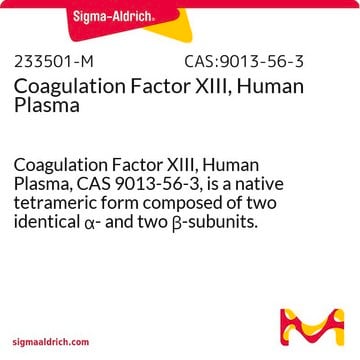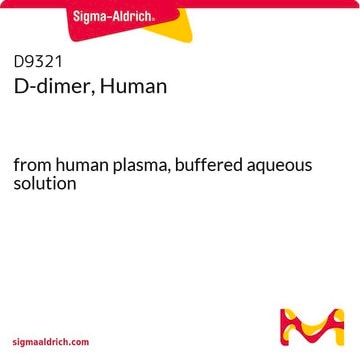Recommended Products
biological source
human plasma
Quality Level
form
powder
technique(s)
indirect ELISA: suitable
SMILES string
N(CC(=O)NC)C(=O)CN
InChI
1S/C5H11N3O2/c1-7-5(10)3-8-4(9)2-6/h2-3,6H2,1H3,(H,7,10)(H,8,9)
InChI key
BWGVNKXGVNDBDI-UHFFFAOYSA-N
General description
Fibrin is produced from cross-linking of fibrinogen by thrombin. Fibrinogen is made up of two monomers each containing three polypeptide chains. Fibrinogen is a major plasma protein.
Application
Fibrin from human plasma has been used:
- for in vitro cleavage of fibrinogen and fibrin
- as a reference for true component analysis (TCA) and principal component analysis (PCA) of Raman spectra
- as a reference in Raman spectroscopy to study the binding mechanisms and the binding efficiency of the different polyoxometalates (POMs)
Biochem/physiol Actions
Fibrin acts as an important bio-polymer in the primary blood clotting process. It creates a scaffold for infiltrating cells during tissue repair. Fibrin is widely used as a tissue sealant for tissue regeneration applications as it enables the formation of a biocompatible physical structure. It is also used in delivery systems for cells and bioactive molecules. The fibrin matrix resembles the native pancreas and can serve as a scaffold material for islet transplantation. Fibrin has been used in studies to obtain fibrin-specific monoclonal antibodies (mAbs). These mAbs may be used to determine their role in fibrin polymerization and use in fibrin quantification in blood plasma.
Preparation Note
Prepared by clotting fibrinogen to yield a crosslinked fibrin
Disclaimer
RESEARCH USE ONLY. This product is regulated in France when intended to be used for scientific purposes, including for import and export activities (Article L 1211-1 paragraph 2 of the Public Health Code). The purchaser (i.e. enduser) is required to obtain an import authorization from the France Ministry of Research referred in the Article L1245-5-1 II. of Public Health Code. By ordering this product, you are confirming that you have obtained the proper import authorization.
Storage Class Code
11 - Combustible Solids
WGK
WGK 3
Flash Point(F)
Not applicable
Flash Point(C)
Not applicable
Choose from one of the most recent versions:
Certificates of Analysis (COA)
Lot/Batch Number
Don't see the Right Version?
If you require a particular version, you can look up a specific certificate by the Lot or Batch number.
Already Own This Product?
Find documentation for the products that you have recently purchased in the Document Library.
Customers Also Viewed
Mehmet Hamdi Kural et al.
Experimental cell research, 319(16), 2447-2459 (2013-07-16)
The processes of development, repair, and remodeling of virtually all tissues and organs, are dependent upon mechanical signals including external loading, cell-generated tension, and tissue stiffness. Over the past few decades, much has been learned about mechanotransduction pathways in specialized
B J De Kort et al.
Acta biomaterialia, 135, 243-259 (2021-09-13)
In situ heart valve tissue engineering is an emerging approach in which resorbable, off-the-shelf available scaffolds are used to induce endogenous heart valve restoration. Such scaffolds are designed to recruit endogenous cells in vivo, which subsequently resorb polymer and produce
Matthew Riopel et al.
Acta biomaterialia, 9(9), 8140-8148 (2013-06-12)
Extracellular matrix (ECM)-integrin stimulation can promote beta cell differentiation, proliferation and function. However, beta cells lose their insulin secretion function in response to glucose stimulation, and senesce when cultured with ECM proteins for a long time. Fibrin is a provisional
Kohji Kasahara et al.
Blood, 122(19), 3340-3348 (2013-09-05)
Membrane rafts are spatially and functionally heterogenous in the cell membrane. We observed that lysenin-positive sphingomyelin (SM)-rich rafts are identified histochemically in the central region of adhered platelets where fibrin and myosin are colocalized on activation by thrombin. The clot
The effect of etanercept on lung leukocyte margination and fibrin deposition after cardiac surgery.
Barry Dixon et al.
American journal of respiratory and critical care medicine, 188(6), 751-754 (2013-09-17)
Our team of scientists has experience in all areas of research including Life Science, Material Science, Chemical Synthesis, Chromatography, Analytical and many others.
Contact Technical Service









